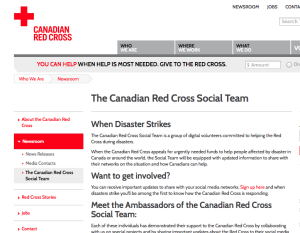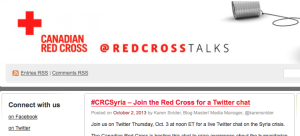How digital volunteers help the Red Cross respond to disasters [case study]
When disasters occur, social media activity increases very suddenly and dramatically for the Canadian Red Cross; people turn to the organization on social media for information, to learn how they can help and to find out how they can receive help. To keep up with this increased volume of activity, the Canadian Red Cross has implemented a team of digital volunteers.
“Without the assistance of digital volunteers, the Canadian Red Cross wouldn’t have the resources to handle this increase of activity in social media,” explains Janice Babineau, Community Manager, Canadian Red Cross. “It’s incredibly important to us that we be able to answer people’s questions, especially when they are looking for our help in times of emergencies.”
Developing a digital volunteer team
Based on the Canadian Red Cross’ experiences with disasters in recent years and the increased adoption of social media, the organization started exploring the use of digital volunteers to respond in early 2013.
“We saw a surge in the use of social media during the Japan earthquake-tsunami-nuclear disaster and again during hurricane Sandy in the U.S. We also saw how the American Red Cross put in place their digital volunteer program to support them during disasters,” says Babineau. “We decided to recruit a small group of digital volunteers from our existing base of supporters on social media, and trained them to respond using their own accounts and profiles.”
When disasters strike, large numbers of people are drawn to the Red Cross social media accounts: blogging, tweeting and otherwise connecting. The Red Cross team pays attention to these engaged individuals and then during quiet times, reaches out to build volunteer relationships. Once volunteers are recruited, the Red Cross provides them with information about the role of the organization in disasters, how to respond to common inquiries and other hands-on training, including the use of monitoring tools.
Responding to the Alberta floods
The Red Cross started to train digital volunteers in the spring of 2013 and soon had a practice opportunity to have some of the volunteers help out during an ice storm in Ontario. Later in the year, a few days into the Alberta floods, the organization realized the volume of activity on social media was beyond their capacity to manage and activated the team of digital volunteers. They volunteers took shifts monitoring social media and responding to people.
The organization also received support from American Red Cross volunteers, who have similar training on the same monitoring tool used by the Red Cross in Canada. They helped over the course of several days, answering many questions and engaging with supporters as well.
“We had an overall 1,400% increase in activity on @redcrosscanada in the two weeks following the Alberta floods,” says Babineau. “The digital volunteers contributed 62 hours of coverage and helped respond to numerous posts on Twitter and Facebook. During this period, we tracked hundreds of tweets that were responded to by volunteers.”
Engaging volunteers between disasters
Keeping volunteers engaged between disasters is a consideration for any Red Cross disaster volunteers across the country. For the digital team, whenever the organization sees an opportunity to engage them or let them know about something going on, they share that information and ask them to participate or help spread the news. A recent example is a Twitter chat hosted by the Red Cross on the topic of the crisis in Syria. Because it was something happening on social media it was of potential interested to the digital volunteers; something in which they might want to participate or promote.
Lessons learned and future plans
When the flooding happened in Alberta, the organization realized that even though they had trained about a dozen people, for a number of reasons (e.g. the floods happened during the summer, over a long weekend), this number was not enough.
According to Babineau, the Red Cross learned some valuable lessons from the Alberta floods experience to apply in improving the digital volunteer program in the future:
- Next time, they will activate the digital volunteer team sooner.
- They need a larger pool of volunteers trained and ready to assist.
- They are making improvements to coordination and scheduling to prevent some of the technical hiccups experienced.
- They need more staff members trained, to help schedule and to help volunteers in case of problems.
“Since the Alberta floods, we have trained additional volunteers and we’re always looking to improve the process. The organization has implemented three rounds of training to date and will continue to offer training on a periodic basis to welcome and prepare more volunteers,” says Babineau.
“This is taking digital volunteering one step further. You don’t need to be on location to help out. You can do it from your home, from a city not affected by the disaster. We’ll look to activate the digital volunteer team again the next time we are in a disaster response and we see a surge of social media activity related to the Canadian Red Cross.”

![How digital volunteers help the Red Cross respond to disasters [case study]](https://nonprofitmarcommunity.com/wp-content/uploads/2013/11/SocialMediaVolunteers.jpg)

 PRINT
PRINT


